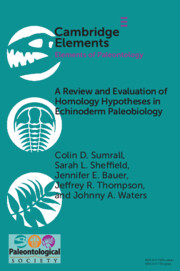Element contents
A Review and Evaluation of Homology Hypotheses in Echinoderm Paleobiology
Published online by Cambridge University Press: 24 March 2023
Summary
- Type
- Element
- Information
- Series: Elements of PaleontologyOnline ISBN: 9781009397155Publisher: Cambridge University PressPrint publication: 13 April 2023
References
- 1
- Cited by



